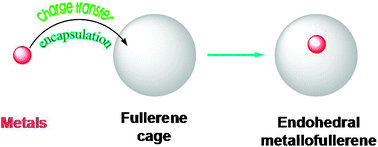Recent breakthroughs achieved in the chemical functionalization of endohedral metallofullerenes (EMFs), especially single crystallographic X-ray characterizations of their derivatives, have presented fundamentally new insights into the structures and properties of these metal–carbon hybrid molecules, and have also brought immense potential applications. In particular, the interplay between the encapsulated metallic species and the fullerene cage has been well investigated. On one hand, the position and motion of the encapsulated metals can be effectively controlled by exohedral modification. On the other hand, the cage structures, the chemical behaviours of cage carbons and thus the chemical reactivity of the whole molecule are also apparently influenced by the electronic configuration and geometrical conformation of the internal metals via strong metal–cage interactions. In this article, we contribute a systematic review of the important chemical transformations of EMFs reported to date, including disilylation, 1,3-dipolar cycloaddition with ylides, cyclopropanation with carbenes and carbanions, cycloaddition with dienes and benzyne, radical reactions, and other miscellaneous reactions, in addition to noncovalent interactions such as supramolecular complexation. The roles that internal metals play in controlling the reactivity of cage carbons are particularly emphasized. Finally, some applicable materials based on EMFs and their derivatives are summarized and practical perspectives are proposed.


 Please wait while we load your content...
Please wait while we load your content...